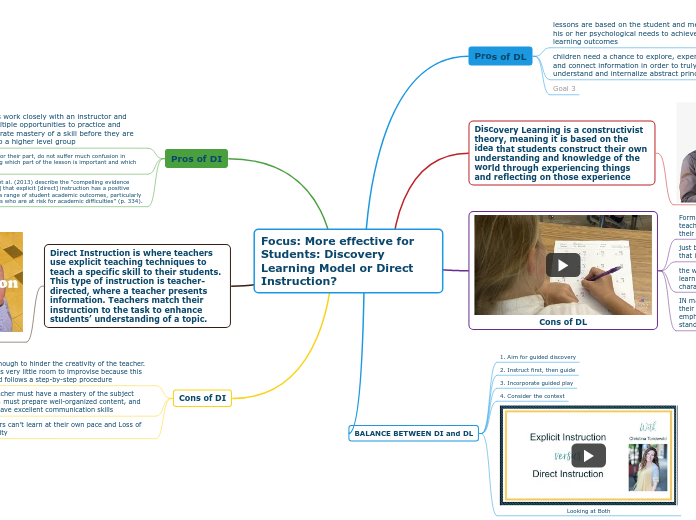Focus: More effective for Students: Discovery Learning Model or Direct Instruction?
This mind map can help you visualize all the information regarding a decision, by providing you with a clear overview that will support you in the process of making the choice.
Cons of DI
Learners can’t learn at their own pace and Loss of creativity
the teacher must have a mastery of the subject matter, must prepare well-organized content, and must have excellent communication skills
rigid enough to hinder the creativity of the teacher. There is very little room to improvise because this method follows a step-by-step procedure
Direct Instruction is where teachers use explicit teaching techniques to teach a specific skill to their students. This type of instruction is teacher-directed, where a teacher presents information. Teachers match their instruction to the task to enhance students’ understanding of a topic.
Subtopic
Pros of DI
After considering all the options and balancing out the advantages and disadvantages, write down your final decision here.
SubBaker et al. (2013) describe the “compelling evidence indicat[ing] that explicit [direct] instruction has a positive impact on a range of student academic outcomes, particularly for students who are at risk for academic difficulties” (p. 334).
Students, for their part, do not suffer much confusion in determining which part of the lesson is important and which part is not.
Students work closely with an instructor and have multiple opportunities to practice and demonstrate mastery of a skill before they are moved to a higher level group
BALANCE BETWEEN DI and DL
Looking at Both
4. Consider the context
3. Incorporate guided play
2. Instruct first, then guide
1. Aim for guided discovery
Cons of DL
IN math for eg. It encourages students to develop their own techniques for basic arithmetic, thus de-emphasizing practice in the use of the efficient standard techniques evolved over the centuries.
the working memory can greatly interfere with learning if it is cluttered with extraneous details characteristic of discovery learning.
just because something is “hands on” does not mean that it is “minds on”
Formal training in this method is necessary for teachers and teachers also have to reflect about how their activity is helping students master a concept
Discovery Learning is a constructivist theory, meaning it is based on the idea that students construct their own understanding and knowledge of the world through experiencing things and reflecting on those experience
Add here all the resources, information, pros, and cons of your potential solution.
By gathering all this information in one place, it becomes easier to identify the best possible solution that will help you reach your goals.
Pros of DL
Add your goals here. Having the goals on the same page as your solution makes it easier to oversee the whole process and choose the best solution.
Goal 3
children need a chance to explore, experience and connect information in order to truly understand and internalize abstract principles
lessons are based on the student and meeting his or her psychological needs to achieve learning outcomes

